Статьи журнала - International Journal of Computer Network and Information Security
Все статьи: 1066
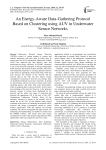
An Energy-Aware Data-Gathering Protocol Based on Clustering using AUV in Underwater Sensor Networks
Статья научная
Underwater Wireless Sensor Networks (UWSNs) consist of certain number of sensors and vehicles interacting with each other to collect data. In recent years, the use of Autonomous Underwater Vehicle (AUV) has improved the data delivery ratio and maximized the energy efficiency in UWSNs. Clustering is one of the effective techniques in energy management which increases the lifetime of these networks. One of the most important parameters in creating optimized clusters is the choice of appropriate cluster head (CH), which not only increases the lifetime of the network and the received data in the sink, but also reduces energy consumption. Clustering of networks was primary done via distributed methods in previous researches. It spends too much energy and also involves too many nodes in the clustering process and fades their main functionality, which is gathering data in sensor networks. It also causes more damping of the network. However, in the proposed protocol, instead of having them distributed by the network and the nodes, the stages of clustering and selecting the appropriate CH is the task of the AUV (Autonomous Underwater Vehicle). Since all the necessary measures to cluster in the network will be carried out by the AUV by this method, many control overheads in the process of clustering the network will be removed and energy consumption caused by nodes reduces significantly. With this method, the network scalability will also be manageable and under control. For simulating and implementing our method we mainly used the OPNET software. The results show that energy consumption of nodes in the proposed algorithm has been significantly improved compared to previous results.
Бесплатно

An Enhanced Dynamic Mutual Authentication Scheme for Smart Card Based Networks
Статья научная
Network security is the prevailing and challenging factor in computer communications. Computer security and communication security are interrelated and essential features in the internetworking system. Network security is ascertained by many factors like authentication, authorization, digital signatures, cryptography, steganography etc. Among them authentication is playing an important role in networked communications, where the communicating partners are to be identified each other legitimately. Authentication process ensures the legitimacy of the communicating partners in networked communication. In an authentication process, the originator of the communication and the respondent transact some identification codes to each other, prior to start of the message transaction. Several methods have been proposed regarding the authentication process for computer communication and smart card based networks from time to time. We introduced a new scheme to enhance and ensure the remote authentication through secure and dynamic authentication using a smart card, which is relatively a different approach. This scheme discusses the authentication procedure for smart card based network systems. This article introduces a dynamic authentication scheme, which includes a number of factors, among them the password, password index, and date of modification are important factors, which decide the dynamicity in authentication. The static approach authentication schemes are vulnerable to different types of attacks in networked communication. This dynamic authentication scheme ensures the authentication, confidentiality, reliability, integrity and security in network communications. This article discusses the implementation of this scheme and to analyze the security and performance factors to ensure the dynamic mutual authentication and to enhance the security features in authentication for smart card based networks.
Бесплатно
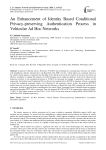
Статья научная
In general, Vehicular Ad hoc Networks (VANETs) are permitting the communication between one vehicle with neighboring vehicles, infrastructure, and Road-Side Unit (RSU). In this, vehicle platoon is commonly known as the vehicle driving pattern it categorizes the batching of the vehicle in the on the trot fashion. It has been reviewed as an effective resolution to mitigate the reduction in traffic blockage and to widen the opulence of the travel. However, the malicious activities of any unauthorized person in VANET are increased the damage to authorized vehicles. In this manuscript, the Identity based Conditional Privacy-Preserving Authentication (ID-CPPA) signature scheme is proposed to detect the malignant command vehicle very efficiently by the consumer vehicle. In this, the proposed ID-CPPA method uses one-way hash functions for improving the efficiency of Road-Side Unit (RSU) signing and verification of a messages. In order to provide better concealment to the vehicle, Phase Truncated Fourier Transform based asymmetric encryption algorithm (PTFT-AE) is proposed. Thus, the proposed ID-CPPA-PTFT-AE approach has achieved 28.96%, 37.58%, 31.36% higher security rate and 25.8%, 37.9%, 42.6% lower delay than the existing MPDC-LPNS, PPSR-GS, and WCAA-TST methods respectively.
Бесплатно
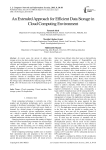
An Extended Approach for Efficient Data Storage in Cloud Computing Environment
Статья научная
In recent years, the advent of online data storage services has been enabled users to save their data and operational programs in cloud databases. Using an efficient and intelligent management helps to optimize quality of provided services. Also it is possible to increase throughput of services by eliminating repeated data. In following article we have offered a completely dynamic approach to detect and eliminate duplicated data which exist in shared storage resources among virtual machines. Results of simulation show that proposed approach, compared to the similar approaches, will save the storage space substantially by reducing usage of CPU, RAM, also will increase rate of de-duplication data up to 23 %.
Бесплатно
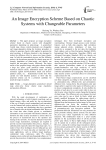
An Image Encryption Scheme Based on Chaotic Systems with Changeable Parameters
Статья научная
This paper proposes an image encryption scheme based on chaotic system with changeable parameters depending on plain-image. A generalized Arnold map, whose control parameters are changeable and image-dependent during the iteration procedure, is utilized to generate chaotic orbits applied to permute the pixel positions. A diffusion function is also designed to realize the diffusion effect by piece-wise linear chaotic map. In both the permutation process and the diffusion process, the keystreams generated by chaotic maps are all strongly dependent on plain-image, and thereby can improve the encryption security efficiently. The major merits of the proposed image encryption scheme include a huge key space, good statistical nature resisting statistical analysis attack, differential attack, and good resistance against known-plaintext attack and chosen-plaintext attack, etc. Experimental results have been carried out with detailed analysis to show that the proposed scheme can be a potential candidate for practical image encryption.
Бесплатно
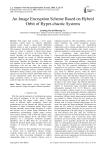
An Image Encryption Scheme Based on Hybrid Orbit of Hyper-chaotic Systems
Статья научная
This paper puts forward a novel image encryption scheme based on ordinary differential equation system. Firstly, a hyper-chaotic differential equation system is used to generate two hyper-chaotic orbit sequences. Introducing the idea of hybrid orbit, two orbits are mixed to generate a hybrid hyper-chaotic sequence which is used to be the initial chaotic key stream. Secondly, the final encryption key stream is generated through two rounds of diffusion operation which is related to the initial chaotic key stream and plain-image. Therefore, the algorithm's key stream not only depends on the cipher keys but also depends on plain-image. Last but not least, the security and performance analysis have been performed, including key space analysis, histogram analysis, correlation analysis, information entropy analysis, peak signal-to-noise ratio analysis, key sensitivity analysis, differential analysis etc. All the experimental results show that the proposed image encryption scheme is secure and suitable for practical image and video encryption.
Бесплатно
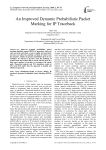
An Improved Dynamic Probabilistic Packet Marking for IP Traceback
Статья научная
An improved dynamic probabilistic packet marking algorithm named IDPPM is presented, which not only can locate and attack a source rapidly and accurately, but also can reduce the marking overhead of routers near the attackers, which is its greatest contribution given by our technique. In contrast to previous work, the challenge of weakest node and weakest link is solved with the price of a little more numbers of packets to reconstruct the attack path. Theoretical analysis and NS2 simulation results in IPv4 and IPv6 testify that the approach is feasible and efficient respectively.
Бесплатно
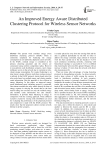
An Improved Energy Aware Distributed Clustering Protocol for Wireless Sensor Networks
Статья научная
The present work considers energy aware distributed clustering protocol (EADC) which is commonly employed for balancing the energy consumption in non-uniformly deployed sensor networks. In the EADC, residual energy is considered as the primary clustering parameter and the clusters are constructed using uniform competition radius. However in non-uniform node distribution scenarios, more energy imbalance occurs in the network due to variation in intra-cluster energy consumption. For counter balancing it, an inter-cluster energy-efficient multi-hop routing protocol is utilized. In the EADC protocol, cluster heads select the relay node based on residual energy and cluster member count information. But this approach is less efficient in energy balancing. In this paper, an improved energy aware distributed equal clustering protocol is projected. Our scheme considers the relay metric directly in terms of energy expense in relaying the sensed data to the base station taking into account not only the residual energy and member count information but also distance information. It provides better balancing of energy in comparison with the existing approach. Three different scenarios created by varying node distribution are used for evaluating the performance of the proposed protocol and comparison is made with the EADC protocol. The results show that the proposed scheme extends network lifetime in all the scenarios.
Бесплатно
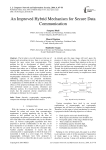
An Improved Hybrid Mechanism for Secure Data Communication
Статья научная
The In today's era with increase in the use of internet and networking devices, there is an increase in demand for more secure data communication. This problem has led to development of hybrid security mechanisms. Various techniques are available in literature that makes use of different steganography and cryptographic mechanisms which has certain pros and cons. In this paper, we propose a new hybrid security mechanism that tries to choose the best cryptographic and steganography mechanism. In addition, to increase the embedding capacity of the proposed mechanism, Huffman encoding scheme is used. The proposed strategy is implemented in MATLAB-09. In order to check the efficacy of the proposed technique three types of analysis were performed named as: security, robustness and efficiency analysis. It is found from the simulation and results that the proposed scheme outperforms other techniques in literature in every aspect.
Бесплатно
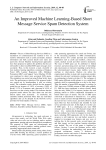
An Improved Machine Learning-Based Short Message Service Spam Detection System
Статья научная
The use of Short Message Services (SMS) as a mechanism of communication has resulted to loss of sensitive information such as credit card details, medical information and bank account details (user name and password). Several Machine learning-based approaches have been proposed to address this problem, but they are still unable to detect modified SMS spam messages more accurately. Thus, in this research, a stack- ensemble of four machine learning algorithms consisting of Random Forest (RF), Logistic Regression (LR), Multilayer Perceptron (MLP), and Support Vector Machine (SVM), were employed to detect more accurately SMS spams. The simulation was carried out using Python Scikit- learn tools. The performance evaluation of the proposed model was carried out by benchmarking it with an existing model. The evaluation results showed that the proposed model has an increase of 3.03% of accuracy, 8.94% of Recall, 2.17% of F-measure; and a decrease of 4.55% of Precision over the existing model. This indicates that the proposed model reduces the false alarm rate and thus detects spams more accurately. In conclusion, the ensemble method performed better than any individual algorithms and can be adopted by the Network service providers for better Quality of Service.
Бесплатно

An Improved Non-Repudiate Scheme-Feature Marking Voice Signal Communication
Статья научная
Guaranteeing the ownership or copyright of digital communication is of extreme importance in this digital era. Watermarking is the technique which confirms the authenticity or integrity of communication by hiding relevant information in specified areas of the original signal such that it might render it difficult to distinguish one from the other. Thus, the digital watermark can be defined as a type of indicator secretly embedded in a noise tolerant signal such as image, audio or video data. The paper presents a voice signal authentication scheme by employing signal features towards the preparation of the watermark and by embedding it in the transform domain with the Walsh transforms. Watermark used in this technique is unique for each member participating in this communication system and makes it is very imperative in the context of signal authentication.
Бесплатно
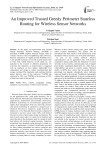
An Improved Trusted Greedy Perimeter Stateless Routing for Wireless Sensor Networks
Статья научная
In this paper, an improvement over Trusted Greedy Perimeter Stateless Routing (T-GPSR) is presented. T-GPSR employs heuristic weight values to evaluate total trust value of neighboring nodes. However, heuristic assignment of weights provide flexibility but it is not suitable in presence of several security attacks such as Grey hole, selfish behavior, on-off attack etc., are launched in the network in different proportions. To overcome this limitation, an improvement is suggested with an emphasis on trust update, lightweight trust computation and storage to reduce communication and storage overhead. The simulation study indicates that the packet delivery ratio of the improved T-GPSR has improved by 10% over T-GPSR in the presence of 50% of malicious nodes in the network.
Бесплатно
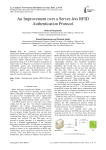
An Improvement over a Server-less RFID Authentication Protocol
Статья научная
With the increased radio frequency identification (RFID) applications different authentication schemes have been proposed in order to meet the required properties. In this paper we analyze the security of a server-less RFID authentication protocol which is proposed by Deng et al. in 2014. Deng et al. proposed an improvement over Hoque et al. protocol to overcome its vulnerability against data desynchronization attack. However, in this paper we show that their protocol is still vulnerable against data desynchronization attack. Furthermore we present an improved version of this protocol to prevent this attack.
Бесплатно
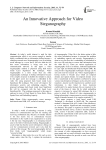
An Innovative Approach for Video Steganography
Статья научная
In today's world internet is used for data communication which is not secure enough to transfer highly confidential data so information hiding become a emerging research area. Steganography is an art to hiding secret message in a cover and it will also hide the fact that secret information is being sent over the communication network. In this paper a video steganography method is proposed using hash based round Least Significant Bit technique. Video steganography is a more secure than any other steganography technique in hiding information because of its complex structure it disables the intruder to attack. In this paper secret text message is embedded in the video file using proposed hash based round Least Significant Bit technique. This work will improve the information security and embedding capacity. The proposed technique hash based round Least Significant Bit will be compared with the hash based Least Significant Bit. The technique proposed in this paper is analysed in term of Peak Signal to Noise Ratio, Mean Square Error and Embedding capacity.
Бесплатно

An Intrusion Detection and Prevention System based on Automatic Learning of Traffic Anomalies
Статья научная
The ever changing network traffic reveals new attack types, which represent a security threat that poses a serious risk for enterprise resources. Therefore, the security administrators are in a real need to employ efficient Intrusion Detection and Prevention Systems, IDPS. Such systems might be capable to learn from the network behavior. In this paper, we present an incremental Learnable Model for Anomaly Detection and Prevention of Zero-day attacks, LMAD/PZ. To facilitate the ability of learning from observations that can provide a reliable model for automatic prevention, a comparison has been carried out between supervised and unsupervised learning techniques. Thus, in LMAD/PZ, the intrusion detection step is integrated with an intrusion prevention plan. To ensure that the prevention plan is dependable and automatic, it must be backed and sustained with robust and accurate detection process. Therefore, two incremental data mining techniques are deeply investigated and implemented on NSL-KDD'99 intrusion dataset. The first technique is the Algorithm Quasi-optimal (AQ), which is a supervised Attributional Rules Learner, ARL, while the second is the Cobweb; an unsupervised hierarchical conceptual clustering algorithm. These algorithms categorize the network connections as either normal or anomalous. The performance of AQ is compared to Cobweb, and the best performance result is integrated with the prevention plan, to afford a fully automated system. The experimental results showed that, the model automatically adapts its knowledge base from continuous network streams, in addition to offering the advantage of detecting novel and zero day attacks. Many experiments have verified that AQ performance outperforms the Cobweb clustering, in terms of accuracy, detection rate and false alarm rate.
Бесплатно
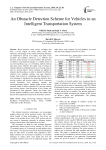
An Obstacle Detection Scheme for Vehicles in an Intelligent Transportation System
Статья научная
Road obstacles cause serious accidents that have a severe impact on driver safety, traffic flow efficiency and damage of the vehicle. Detecting obstacles are important to prevent or to reduce such kind of the accidents and fatalities. However, it is difficult and becomes tricky because of some problems like presence of shadow, environmental changes or a sudden action of any moving things (e.g., car overtaking, animal coming) and many more. Thereby, this paper aims to design an obstacle detection technique based on (i) moving cameras and (ii) moving objects. These methods are applied to obstacle detection phase, in order to identify the different obstacles (e.g., potholes, animals, stop sign, obstacles, bumps, road cracks) by considering road dimensions. A new technique is introduced for detecting obstacles from moving camera and moving objects which overcomes several limitations over stationary cameras and moving/stationary objects. Further, paper reviews recent research trends to detect obstacles for moving cameras and moving objects with discussion of key points and limitations of each approach. Finally, the results show that the proposed method is more robust and reliable than the previous approaches based on the stationary cameras.
Бесплатно

An Optimized Authentication Mechanism for Mobile Agents by Using Machine Learning
Статья научная
A mobile agent is a small piece of software which works on direction of its source platform on a regular basis. Because mobile agents roam around wide area networks autonomously, the protection of the agents and platforms is a serious worry. The number of mobile agents-based software applications has increased dramatically over the past year. It has also enhanced the security risks associated with such applications. Most of the security mechanisms in the mobile agent architecture focus solely on platform security, leaving mobile agent safety to be a significant challenge. An efficient authentication scheme is proposed in this article to address the situation of protection and authentication of mobile agent at the hour of migration of across multiple platforms in malicious environment. An authentication mechanism for the mobile agent based on the Hopfield neural network proposed. The mobile agent’s identity and password are authenticate using the specified mechanism at the moment of execution of assigned operation. An evaluative assessment has been offered, along with their complex character, in comparison to numerous agent authentication approaches. The proposed method has been put into practice, and its different aspects have been put to the test. In contrasted to typical client-server and code-on-demand approaches, the analysis shows that computation here is often more safe and simpler.
Бесплатно
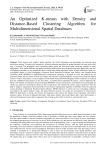
Статья научная
From massive and complex spatial database, the useful information and knowledge are extracted using spatial data mining. To analyze the complexity, efficient clustering algorithm for spatial database has been used in this area of research. The geographic areas containing spatial points are discovered using clustering methods in many applications. With spatial attributes, the spatial clustering problem have been designed using many approaches, but non-overlapping constraints are not considered. Most existing data mining algorithms suffer in high dimensions. With non-overlapping named as Non Overlapping Constraint based Optimized K-Means with Density and Distance-based Clustering (NOC-OKMDDC),a multidimensional optimization clustering is designed to solve this problem by the proposed system and the clusters with diverse shapes and densities in spatial databases are fast found. Proposed method consists of three main phases. Using weighted convolutional Neural Networks(Weighted CNN), attributes are reduced from the multidimensional dataset in this first phase. A partition-based algorithm (K-means) used by Optimized K-Means with Density and Distance-based Clustering (OKMDD) and several relatively small spherical or ball-shaped sub clusters are made by Clustering the dataset in this second phase. The optimal sub cluster count is performed with the help of Adaptive Adjustment Factor based Glowworm Swarm Optimization algorithm (AAFGSO). Then the proposed system designed an Enhanced Penalized Spatial Distance (EPSD) Measure to satisfy the non-overlapping condition. According to the spatial attribute values, the spatial distance between two points are well adjusted to achieving the EPSD. In third phase, to merge sub clusters the proposed system utilizes the Density based clustering with relative distance scheme. In terms of adjusted rand index, rand index, mirkins index and huberts index, better performance is achieved by proposed system when compared to the existing system which is shown by experimental result.
Бесплатно
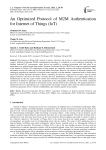
An Optimized Protocol of M2M Authentication for Internet of Things (IoT)
Статья научная
The Internet of Things (IoT) consists of sensors, networks, and services to connect and control production systems. Machine-to-Machine (M2M) communication technology is considered as a key underlying technology for building Industrial IoT environments where devices are enabled to exchange information with each other in an autonomous way without human intervention. Resource-Constrained Devices (RCD) have found an expanding demand in the Internet of Things (IoT) applications as these gadgets are essentially working with delicate information. Thus, information security has ended up vital for both makers and clients. However, the creation of defenseless gadgets still challenging regarding the restriction of involved assets especially with the attackers ‘continuous trials to misuse these restrictions chasing important information. Hence, connecting an open key crypto-system becomes a must to extend gadget proficiency and relieve the chance of touchy data loss. Deployments of Elliptic curve cryptography (ECC) are fundamentally an open key crypto-system with the basic distinction of speedier advancing capacity whereas yielding an assortment of distinctive approaches to the arrangement of the cryptographic calculation. We will submit a proposed protocol to overcome the demands of information security and the speed of data circulation. The proposed protocol is characterized by low computational cost, communication and storage overhead, while achieving mutual authentication, session key agreement, device’s identity confidentiality, and resistance against various attacks.
Бесплатно

An Overview of Vertical Handoff Decision Making Algorithms
Статья научная
Uncontrollable development of wireless and mobile communication technology aims to provide the seamless continuous connection to access various wireless technologies and to have connection with the best network which provides the best quality of service (QoS). Each application requires different QoS, so the network selection may vary accordingly. To achieve this goal and to select the best network for a mobile terminal when moving from one network to another, it is necessary to have a good decision making algorithm which decides the best network for a specific application that the user needs based on QoS parameter. This paper presents an overview of handoff types, handoff process, and classification of vertical handoff, parameters required, existing work and the comparison table.
Бесплатно

